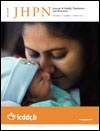Preference for Institutional Delivery and Caesarean Sections in Bangladesh
DOI:
https://doi.org/10.3329/jhpn.v31i1.14754Keywords:
Caesarean sections, Delivery settings, Logistic regression, Pregnancy, BangladeshAbstract
In Bangladesh, preference for place of delivery and socioeconomic factors associated with caesarean section are not well-understood. This paper examines the socioeconomic correlates of preference for institutional delivery and caesarean sections in Bangladesh. The study used data from the nationally-representative 2007 Bangladesh Demographic and Health Survey. Both bivariate and multivariate binary logistic regression models were constructed to assess the effect of sociodemographic factors on the use of medical facilities and caesarean section for childbirth. Overall, 15% of women underwent institutional delivery, and 8% deliveries were performed by caesarean sections. Both institutional deliveries and caesarean sections have increased in recent years. The bivariate and multivariate analyses both confirmed that place of residence, religion, birth order, frequent pregnancy, antenatal care-seeking, and wealth index were important predictors of the use of medical facilities and caesarean sections for childbirth. Womens education appeared as the most single significant determinant for the use of both services. The findings underlie the importance of monitoring caesarean section as well as professional attendance for safe motherhood. Programmes should aim to inform women highlighting the benefits of the use of skilled maternal healthcare services and demerits of home-delivery practices.
J HEALTH POPUL NUTR 2013 Mar;31(1):96-109
Downloads
582
443

